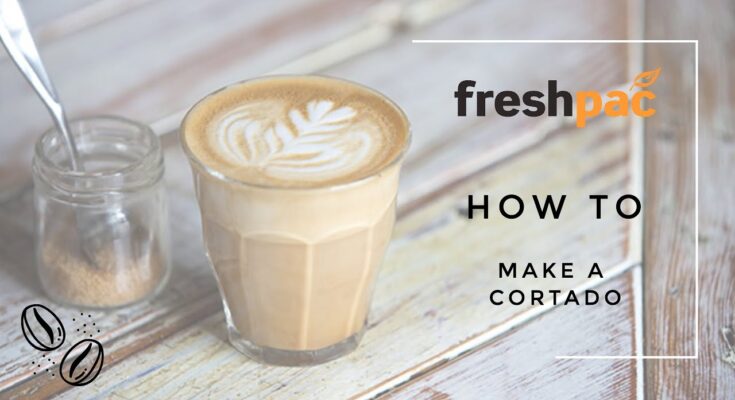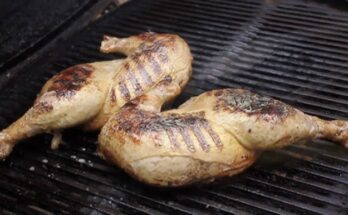Cortado Recipe: If you’re a fan of rich, bold coffee but still crave that smooth creaminess of milk, the cortado might just become your new favorite drink. A cortado is a small coffee beverage, traditionally composed of equal parts espresso and warm milk. Unlike a latte or cappuccino, it doesn’t come with a heavy foam top or large volume of milk. This drink is all about balance—cutting the acidity and intensity of espresso with just enough milk to make it smooth without overshadowing the coffee’s robust flavor.
The word “cortado” comes from the Spanish verb cortar, meaning “to cut.” It’s a nod to the milk cutting through the espresso, toning down its intensity without losing its essence. Served in a small glass (typically 4–6 oz), it’s perfect for those moments when you want something stronger than a latte but smoother than a straight espresso shot.
So whether you’re just getting into espresso drinks or looking to expand your coffee repertoire, the cortado is a great starting point.
Origins and Cultural Significance
Cortado originates from Spain, specifically from the coffee culture of Madrid and the Basque Country. Over time, it made its way to Latin America and then into coffee shops worldwide. In places like Cuba and Colombia, cortado has become a staple for mid-day or after-meal coffee rituals.
Unlike some trendy coffee creations, the cortado holds its roots in tradition. It’s not about flashy latte art or extra syrups—it’s all about the pure, unadulterated harmony between espresso and milk. In Spain, you’ll often find it served at neighborhood cafés, where locals sip slowly while catching up with friends or enjoying a quiet break.
Today, it has found its way into hip cafes and coffee houses in North America, loved by those who appreciate the stronger punch of coffee with just a touch of milk.
Essential Ingredients for a Perfect Cortado
Espresso – The Bold Foundation
To make a great cortado, you first need great espresso. That’s your base—the essence of coffee flavor. Espresso is a concentrated form of coffee brewed by forcing hot water through finely-ground coffee beans. It’s known for its bold, intense flavor and rich crema, the golden foam that sits on top of a well-pulled shot.
For cortado, quality really matters. You don’t want a bitter or weak espresso because it won’t stand up well to the milk. Opt for freshly ground coffee beans with a medium to dark roast, as they provide a rich body and lower acidity—perfect for balancing with milk.
Use about 18–20 grams of coffee for a double shot (around 2 ounces of espresso). If you have an espresso machine, that’s ideal. If not, a Moka pot or AeroPress can be a decent substitute. Just make sure the coffee is strong, smooth, and not overly bitter.
Milk – The Creamy Companion
Milk in a cortado isn’t just a sidekick—it’s an equal partner. You’re looking for a 1:1 ratio, which means your milk should be warm and slightly textured, but not overly foamy like in a cappuccino. The milk should be steamed to about 130°F to 150°F (54°C to 65°C), maintaining its natural sweetness and creating a silky texture.
Whole milk is the classic choice because of its creaminess, but you can use alternatives like oat milk or almond milk if you’re dairy-free. Just make sure they steam well—some plant-based milks separate when heated.
The goal here is to create microfoam: smooth, velvety milk with tiny bubbles that mix seamlessly into your espresso. It should be light enough to complement the coffee, not dominate it.
Equipment You’ll Need
Espresso Machine or Moka Pot
The backbone of a cortado is espresso, so having a reliable espresso machine will definitely up your coffee game. Whether it’s a semi-automatic machine, a manual lever model, or even a high-end super-automatic, consistency in pressure and temperature is key.
If you don’t own an espresso machine, a Moka pot is a solid alternative. While it doesn’t create true espresso, it makes a strong, concentrated brew that works well in a pinch. Some even use AeroPress with espresso-style recipes to approximate that bold espresso shot.
Milk Steamer or Frother
Steamed milk isn’t the same as foamed milk. For a cortado, you want your milk warm and lightly textured—not bubbly. A built-in steam wand on your espresso machine is ideal. But if you don’t have one, a handheld frother or even a stovetop milk steamer can work with a bit of practice.
The key is to keep the milk’s temperature just right and to stop steaming before large bubbles start forming.
Cups and Serving Suggestions
A cortado is traditionally served in a small 4-ounce Gibraltar glass. It’s the perfect size to hold your espresso and milk in equal parts, and the clear glass lets you appreciate the beautiful layering of the drink.
If you don’t have a Gibraltar glass, any small heatproof glass or ceramic demitasse cup will work. Just avoid oversized mugs—they’ll throw off the ratio and aesthetic.
Step-by-Step Cortado Recipe
Step 1: Brewing the Espresso
- Begin by grinding your coffee beans fresh, using a burr grinder if possible. You want a fine espresso grind—slightly finer than table salt.
- Dose about 18–20 grams of coffee into your portafilter. Tamp evenly with firm pressure.
- Pull a double shot of espresso, aiming for 2 ounces in about 25–30 seconds. The espresso should have a thick crema and rich aroma.
- If using a Moka pot or AeroPress, brew your coffee strong and concentrated. You want intensity here to match the milk.
Step 2: Steaming the Milk
Steaming milk for a cortado is a delicate process that requires precision to achieve the perfect texture and temperature. The goal is to create a smooth, velvety microfoam that complements the espresso without overpowering it.
1. Choose the Right Milk:
- Whole Milk: Preferred for its rich texture and natural sweetness.
- Alternative Milks: Oat milk is a popular non-dairy option due to its ability to froth well and its creamy consistency.
2. Steaming Process:
- Temperature: Heat the milk to approximately 130°F to 150°F (54°C to 65°C). This range ensures the milk is warm enough to blend seamlessly with the espresso without scalding, which can alter the taste.
- Technique: Submerge the steam wand just below the surface of the milk. Start with the tip near the surface to introduce air, creating microfoam. Then, submerge it deeper to heat the milk evenly. The process should create a whirlpool effect, ensuring uniform texture.
3. Achieving Microfoam:
- Consistency: Aim for a texture similar to wet paint—smooth and glossy. Avoid large bubbles; the foam should be fine and integrated.
- Avoiding Over-Frothing: Unlike cappuccinos, cortados require minimal foam. The milk should be steamed to a point where it’s slightly textured but not frothy.
4. Steaming Without a Steam Wand:
- Stovetop Method: Heat milk in a saucepan until it reaches the desired temperature. Use a whisk to create a slight froth.
- Microwave Method: Pour milk into a microwave-safe jar, heat it, then shake vigorously to create microfoam.
- Handheld Frother: These devices can effectively create the desired texture when used correctly.
5. Tips for Perfect Steamed Milk:
- Use Fresh Milk: Fresh milk steams better and provides a sweeter taste.
- Clean Equipment: Ensure your steam wand or frother is clean to prevent any off-flavors.
- Practice: Perfecting milk steaming takes time. Practice to understand how different milk types behave.
Step 3: Pouring and Layering
The final step in crafting a cortado is combining the espresso and steamed milk. This process requires a gentle hand to maintain the balance and integrity of both components.
1. Preparing the Espresso:
- Freshness: Use freshly brewed espresso to ensure optimal flavor.
- Serving Vessel: A small glass, typically 4–6 oz, is ideal for a cortado. The Gibraltar glass is a popular choice.
2. Pouring Technique:
- Angle the Glass: Tilt the glass slightly to allow the milk to slide beneath the crema, preserving the espresso’s top layer.
- Slow and Steady: Pour the steamed milk slowly, starting from a low height and gradually increasing as the glass fills.
- Creating Layers: The goal is to achieve a harmonious blend where the milk and espresso integrate seamlessly, often resulting in a light brown color with a thin layer of microfoam on top.
3. Latte Art (Optional):
- Skill Level: While not traditional for cortados, skilled baristas may add simple latte art.
- Techniques: Basic designs like hearts or tulips can be achieved with practice.
4. Serving:
- Temperature: Serve immediately to enjoy the optimal temperature and texture.
- Accompaniments: A cortado pairs well with light pastries or can be enjoyed on its own.
5. Tips for Perfect Pouring:
- Consistent Milk Texture: Ensure the milk maintains its microfoam consistency throughout the pour.
- Control: Practice controlling the flow of milk to prevent disrupting the espresso layer.
- Clean Presentation: Wipe any spills or drips from the glass for a professional appearance.
Tips for the Best Cortado Experience
Crafting the perfect cortado goes beyond just following steps; it’s about understanding the nuances that elevate the drink.
1. Milk Texture Matters:
- Microfoam Quality: The milk should have a silky texture with tiny, uniform bubbles.
- Avoid Over-Frothing: Excessive foam can overpower the espresso, disrupting the balance.
2. Coffee to Milk Ratio:
- Traditional Ratio: Maintain a 1:1 ratio of espresso to steamed milk.
- Adjusting Strength: For a stronger coffee flavor, slightly reduce the milk volume.
3. Choosing the Right Beans:
- Roast Level: Medium to dark roasts are preferred for their bold flavors.
- Freshness: Use freshly roasted beans to capture the full spectrum of flavors.
4. Equipment Quality:
- Espresso Machine: A reliable machine ensures consistent espresso shots.
- Grinder: A burr grinder provides uniform coffee grounds, essential for espresso.
5. Practice and Patience:
- Skill Development: Perfecting a cortado requires practice, especially in milk steaming and pouring techniques.
- Experimentation: Don’t hesitate to try different beans or milk types to find your preferred flavor profile.
Flavor Variations and Creative Twists
Spicing It Up: Add Cinnamon, Vanilla, or Cocoa
A classic cortado is beloved for its simplicity, but if you’re in the mood for a little extra flair, subtle flavor additions can elevate your experience without overwhelming the drink’s integrity. Here are a few tasteful ways to spice things up:
- Cinnamon: Sprinkle a bit of ground cinnamon on top or infuse your milk during steaming for a warm, spicy aroma that complements espresso’s boldness.
- Vanilla: A drop or two of vanilla extract added to your milk before steaming can lend a creamy sweetness that blends beautifully with coffee.
- Cocoa Powder: Light dusting on top or a small pinch in the espresso itself brings a mocha-like richness perfect for chocolate lovers.
These additions not only enhance flavor but also create a more aromatic and indulgent coffee moment—great for brunch or impressing guests.
Using Plant-Based Milks
For those who prefer or need dairy-free alternatives, you’ll be glad to know that cortados can be just as delicious with plant-based milk. However, not all plant milks behave the same when steamed:
- Oat Milk: Creamy and sweet, this is one of the best options for cortados. It froths well and doesn’t separate easily.
- Almond Milk: Nutty and light, almond milk can complement espresso’s richness, though some brands may curdle with heat.
- Soy Milk: A solid choice for froth and creaminess, but it can have a slightly bean-like aftertaste.
- Coconut Milk: Adds a tropical twist, though it’s thinner in consistency.
When choosing plant-based options, look for barista-blend varieties—they’re formulated to steam better and produce a foam similar to dairy milk.
Pairing Your Cortado
Ideal Foods to Serve with a Cortado
Because of its size and strong flavor, a cortado pairs best with lighter, less sweet snacks that don’t overpower your palate. Think of it more like a midday or post-meal beverage than a breakfast staple.
- Almond Biscotti: Its subtle sweetness and crunch pair beautifully with cortado’s smooth bite.
- Dark Chocolate Squares: A classic pairing—bitterness from the chocolate echoes the espresso while the milk smooths it all out.
- Fruit Tarts or Scones: Light pastries with fruit or jam offer just enough sweetness to balance the drink.
You can also enjoy a cortado alongside savory snacks like cheese toast or croquettes for a more continental café feel.
Best Time of Day for Cortado
Traditionally enjoyed in the late morning or after a meal, cortado is ideal for those times when you want a satisfying coffee but don’t need a caffeine jolt. Its compact size and smooth profile make it great for:
- Mid-morning breaks
- After lunch as a digestif
- Evening social moments, especially when served decaf
It’s essentially a “sophisticated espresso” that doesn’t require the commitment of a full latte or cappuccino.
Cortado vs Other Espresso Drinks
How Does It Compare to a Latte or Flat White?
To truly appreciate a cortado, it helps to understand how it differs from other beloved espresso-based drinks:
| Drink | Espresso | Milk | Foam | Total Volume |
|---|---|---|---|---|
| Cortado | 1:1 | Lightly steamed | Little to none | ~4 oz |
| Latte | 1:3 | Steamed | Light layer | ~8-12 oz |
| Flat White | 1:2 | Steamed | Microfoam | ~6 oz |
| Cappuccino | 1:1 | Steamed | Thick foam | ~6 oz |
The cortado stands out because it preserves the coffee’s strength while just rounding off its edges with warm milk. No frothy domes, no heavy milk texture—just smooth, bold, and balanced.
FAQs about Cortado Recipe
1. What is a cortado?
A cortado is a Spanish espresso-based coffee drink made with equal parts espresso and warm milk. The milk cuts through the espresso’s acidity without overpowering its bold flavor.
2. How is a cortado different from a latte or cappuccino?
Unlike a latte or cappuccino, which contain more milk and foam, a cortado has a 1:1 ratio of espresso to steamed milk and almost no foam. This makes it stronger and less creamy than the others.
3. What kind of milk is best for a cortado?
Whole milk is traditionally used for its rich, smooth texture, but you can also use plant-based alternatives like oat, almond, or soy milk. Just ensure it steams well and doesn’t curdle.
4. Do I need a milk frother to make a cortado?
While a frother is helpful, it’s not essential. You can heat the milk on the stove or in a microwave, then whisk or shake it vigorously until slightly textured but not foamy.
5. Can I make a cortado without an espresso machine?
Yes! You can use a stovetop Moka pot or a strong brew from an AeroPress to mimic espresso. Just make sure the coffee is rich and concentrated.
6. How many shots of espresso are in a cortado?
A cortado typically contains one or two shots of espresso, depending on your preference and the cup size.
7. What size is a cortado cup?
Cortados are usually served in small 4 to 5-ounce glass cups, often called Gibraltar glasses in the U.S.
8. Is a cortado sweet?
No, cortados are not inherently sweet. However, you can add a touch of sugar or flavored syrup if you prefer a sweeter profile.
9. Can I add flavors to a cortado?
Absolutely. While traditional cortados are plain, you can enhance yours with a dash of vanilla, cinnamon, or caramel for a personalized twist.
10. Is a cortado stronger than regular coffee?
Yes, a cortado has a bolder flavor and higher caffeine concentration than regular drip coffee due to the espresso base and minimal milk content.
Conclusion
The cortado may be small, but it delivers a mighty flavor punch. With just two ingredients—espresso and milk—it captures the heart of coffee craftsmanship. Whether you’re a seasoned espresso aficionado or a curious home brewer, mastering the cortado offers a satisfying and sophisticated experience. From selecting the right beans and perfecting your milk texture to nailing the final pour, it’s a ritual that’s both artistic and delicious.
So, next time you’re in the mood for a coffee that’s strong yet smooth, minimal but indulgent, remember: a cortado might be just what you need.



